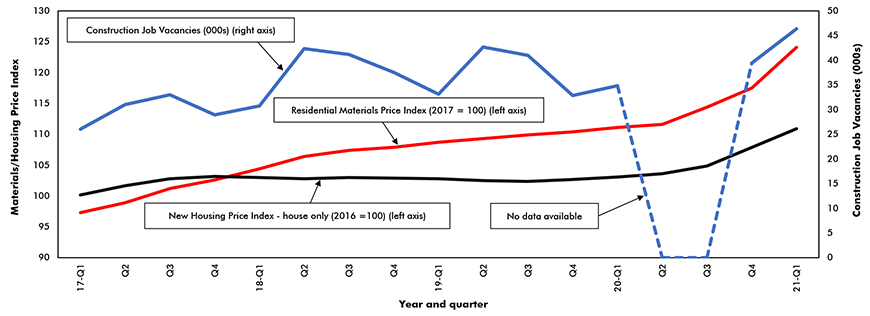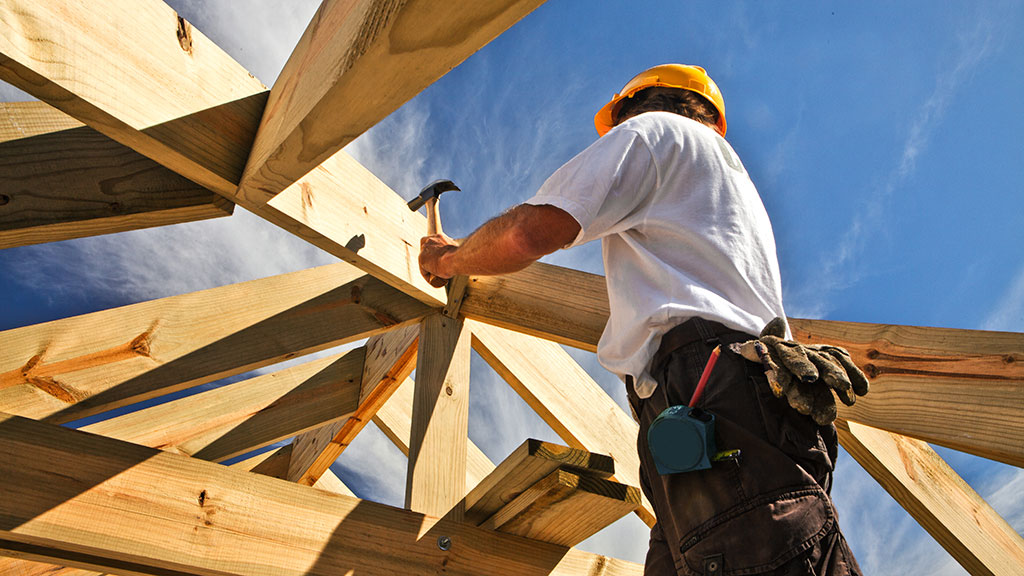This snapshot focuses on the persisting impact of the post-pandemic surge of residential construction on employment and the job vacancy rate in the industry. It also looks at the stock of completed and unoccupied dwellings which over the past 18 months has shrunk to a seven-year low.
The evidence of a countrywide decline in the inventory of available dwellings and the signs of a growing shortage of skilled labour, plus an unprecedented increase in the price of lumber and other sawmill products, have helped push the new house price index up +12.9% y/y, a 15-year high. The big question, of course, is will new house prices soon cool?
Surge in hiring sends construction job vacancies to record high
Following the first wave of COVID-19 in early 2020, employment in construction rose mainly due to a surge in housing demand reflected by record sales of both new and existing homes. This triggered a rapid acceleration in new residential construction and renovation. Since April of last year, construction employment in Canada, +20.4%, has increased by more than the all-industry advance, +16.4%.
The escalation in demand for construction workers is reflected by two other measures. First, average weekly earnings in the industry have risen by +9.5% over the past 12 months, significantly more than the all-industry increase of +1.1%. Second, according to Statistics Canada, the number of job vacancies in construction jumped from 39,425 in the final quarter of 2020 to a record high of 46,370 in the first quarter of 2021. The unprecedented number of job vacancies highlights just how much the demand for construction workers across most trades has outpaced the supply. Trades with particularly large year-over-year increases in job vacancies include masonry and plastering; electrical; carpenters and cabinetmakers; and construction helpers.
Across the country, the gains in construction employment are, not surprisingly, consistent with year-to-date increases in total construction spending. At the top of the job-creation list is Quebec, where a +40% year-to-date increase in the volume of construction spending has boosted hiring in the industry by +21%, while also lifting average weekly earnings by +28% and raising the number of vacant construction jobs over the past four quarters by +50%.
In British Columbia, fuelled in large part by a +40% year-to-date increase in housing starts, construction employment has risen by +6.8% year to date. The construction job vacancy rate in B.C. has increased from 5.3% to a country-leading 6.5% and hourly wages being offered are ahead by +8.1%.
Other provinces exhibiting evidence of a shortage of construction workers include Ontario, with 13,400 (+20% y/y) vacant positions; Alberta with 6,200 (+20% y/y); Manitoba, 1,500 (+116% y/y); Nova Scotia, 1,100 (+285% y/y); and New Brunswick, 905 (+166% y/y).
Strong demand + labour & material shortages send one signal
The year-to-date increase in housing starts, shrinkage in the number of completed and unoccupied dwellings since late 2019 and the above-noted sharp rise in new home prices indicate that the supply of new dwellings is failing to keep up with demand. Moreover, the shortages of construction materials, specifically lumber and veneer and plywood, have pushed residential construction costs in Canada’s eleven largest census metro areas up by +12% year over year.
Going forward, although lumber futures have trended sharply lower from the peak of $1,686 USD per 1,000 board feet they reached in early May, the embedded effect of their +105% year-to-date increase will continue to exert upward pressure on new house prices well into the second half of this year. In addition, higher labour costs resulting from the shortage of construction workers will likely put additional upward pressure on construction costs over the next several quarters.
If the government lets the Canadian Emergency Response Benefit (CERB) program expire at the end of September, as it has announced, the above-noted rise in offered wages may attract more (mainly younger) individuals to work in construction, thereby helping to reduce the industry’s high job vacancy rate.
Against this background of rising construction costs and constrained supply, housing demand should remain strong given that the Bank of Canada is in no hurry to raise interest rates, consumer confidence is almost in orbit and net international migration is accelerating rapidly. Not surprisingly, the combination of strong demand and limited supply suggests that upward pressure on house prices will persist well into 2022.
John Clinkard has over 35 years’ experience as an economist in international, national and regional research and analysis with leading financial institutions and media outlets in Canada.
Construction Job Vacancies, Residential Material Prices
and New House Prices — Canada

Chart: ConstructConnect — CanaData.
Please click on the following link to download the PDF version of this article:
Economic Snapshot Vol. 19, Issue 13 – Labour shortages + high material costs + strong demand = more pressure on house prices – PDF










Recent Comments
comments for this post are closed